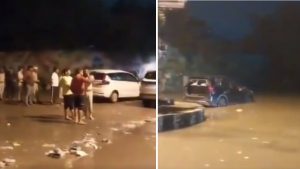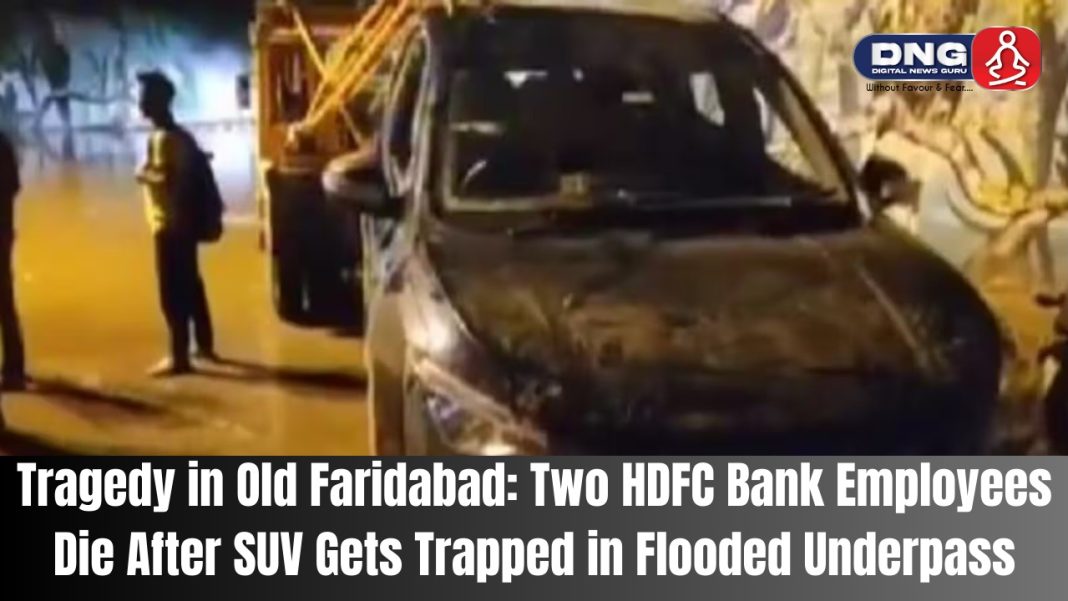DIGITAL NEWS GURU HARYANA DESK:
Tragedy in Old Faridabad: Two HDFC Bank Employees Die After SUV Gets Trapped in Flooded Underpass
In a heartbreaking incident, two HDFC Bank employees lost their lives after their SUV became trapped in a flooded underpass in Old Faridabad, Haryana, on the night of September 13, 2024.
The victims, identified as Punyashreya Sharma, the manager of the HDFC Bank branch in Gurugram’s Sector 31, and Viraj Dwivedi, a cashier at the same branch, were on their way home when their vehicle became submerged in floodwaters. The tragedy has sparked concerns over urban planning, infrastructure shortcomings, and the general disregard for safety during monsoon season in the Delhi-NCR region.
The Incident: What Happened?
The incident took place at the Old Faridabad railway underpass, a low-lying area that is prone to waterlogging during heavy rains. Due to continuous rainfall throughout the day, the underpass had become flooded with water several feet deep. Despite the precarious situation, Sharma and Dwivedi, traveling in their Mahindra XUV700, attempted to navigate through the waterlogged passage late that night.
Reports indicate that the duo either misjudged the depth of the water or failed to notice any warning signs, leading them to drive straight into the submerged underpass. Unfortunately, once their SUV entered the water, it became stuck, and floodwaters quickly began filling the vehicle. Despite attempts by onlookers and passersby to rescue the trapped men, the floodwater overwhelmed the vehicle, making it impossible for them to escape in time.
Rescue Efforts and Fatal Outcome

Local residents, upon realizing the gravity of the situation, immediately tried to help the occupants of the SUV. Some reports suggest that people in the vicinity tried to assist by using ropes and makeshift tools to pull the men out of the submerged vehicle. However, their efforts were ultimately in vain.
Viraj Dwivedi, the cashier, succumbed to the accident almost immediately, as emergency responders arrived on the scene but were unable to revive him. Punyashreya Sharma, the manager, was pulled from the vehicle and rushed to Badshah Khan Civil Hospital. Unfortunately, he was declared dead on arrival. Dwivedi’s body was not recovered until around 4 a.m. the next morning, after an extensive search by rescue teams.
Authorities, including the local police and fire department, reached the scene shortly after the incident was reported, but by then, it was too late to save the lives of the two men.
Heavy Rainfall and Poor Infrastructure: A Lethal Combination

The unfortunate deaths of Sharma and Dwivedi are part of a larger narrative of infrastructure issues and urban mismanagement in India’s National Capital Region (NCR), especially during the monsoon season. The region, which includes parts of Delhi, Gurugram, and Faridabad, frequently experiences heavy downpours during this period, often leading to severe waterlogging, traffic snarls, and flooding in low-lying areas. These conditions are exacerbated by poor drainage systems and inadequate urban planning.
The Old Faridabad underpass is notorious for flooding during rains, with residents often complaining about the lack of permanent solutions to address the waterlogging. While the local administration does put up barricades or signs during extreme weather conditions, it appears that either the warnings were insufficient on this occasion, or they were disregarded. Some reports indicate that cautionary barricades may have been ignored by the victims, but this is still being investigated.
Blame and Accountability: Who’s Responsible?

As the families of the victims mourn their untimely deaths, the tragedy raises critical questions about accountability and responsibility. Local authorities had reportedly issued warnings earlier in the day, anticipating heavy rains and the possibility of waterlogging in several areas, including the Old Faridabad underpass. The India Meteorological Department (IMD) had issued an orange alert for the region, warning of severe rainfall that could result in flooding in low-lying areas.
Despite these warnings, many are questioning whether enough was done to prevent such accidents. Was there adequate signage, and were roads blocked off completely? Did authorities do enough to stop drivers from entering these hazardous zones, or were the warnings easily overlooked?
Moreover, there is the issue of long-standing infrastructure challenges in the region. The underpass in question has flooded numerous times in the past, yet no lasting solutions have been implemented to address the problem. In urban areas that are prone to such issues, flood management systems, better drainage networks, and early response teams need to be prioritized to prevent tragedies like this.
The Aftermath: Calls for Action

In the wake of this disaster, residents and urban planners alike are calling for better infrastructure development in the region to prevent future tragedies. The lack of proper drainage systems, outdated infrastructure, and the general unpreparedness for heavy rainfall are issues that plague not only Faridabad but the entire Delhi-NCR region. With cities growing rapidly and climate change making extreme weather events more frequent, there is an urgent need to adapt urban planning and governance to these new realities.
Experts argue that authorities must invest in more comprehensive flood management systems, build proper drainage infrastructure, and enforce strict zoning regulations in flood-prone areas. Additionally, local governments must take proactive measures during the monsoon season, including deploying emergency response teams, installing clear barricades, and ensuring that roads leading to flooded areas are blocked off entirely.
Conclusion: A Heartbreaking Loss and a Wake-up Call
The tragic deaths of Punyashreya Sharma and Viraj Dwivedi serve as a grim reminder of the dangers posed by heavy rainfall and inadequate urban infrastructure in India’s major cities. Their loss is not just a personal tragedy for their families but also a call for action for both authorities and citizens to take road safety and flood risks more seriously during the monsoon season. In the short term, this incident highlights the importance of heeding weather warnings and exercising caution when driving through potentially hazardous areas.
In the long term, however, it underscores the urgent need for better planning, improved infrastructure, and a more robust response system to deal with the increasing threat of flooding in urban areas across India. If these issues are not addressed, tragedies like the one in Old Faridabad may continue to occur.
YOU MAY ALSO READ: Prime Minister Modi Launches Six New Vande Bharat Trains








